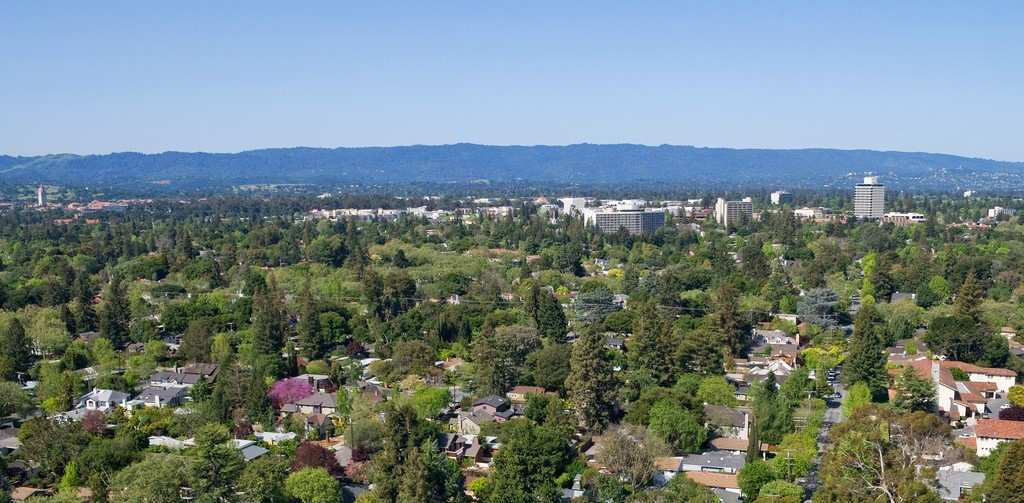- About Us
- Our Work
- Tree Info
- Get Involved
- Blog
- Support Us

Urban trees combat climate change, enhance public health, and contribute to vibrant, sustainable communities. Protecting and caring for existing trees and planting new trees are critical to ensuring the health and longevity of our urban canopy.
In June 2022, Palo Alto’s City Council voted to update the city’s Tree Protection Ordinance, the first substantive changes to the law since 2002. The update process began in 2018, led by the city’s former urban forester Walter Passmore, but ramped up in the last 18 months with the support of current urban forester Peter Gollinger, city staff, residents, and community environmental organizations.
The updated ordinance protects more trees and promotes planting of locally native species and drought-tolerant species, which are vital for sustaining the city’s urban forest. It also implements a number of changes that affect proposed removals of protected trees, protected tree care and maintenance, public notification requirements, and permit appeals.
Learn more about these changes that will protect Palo Alto’s mature, abundant, and vibrant tree canopy at the City of Palo Alto’s website.
Expands the definition of “protected” tree
“Protected” tree includes the three species that were already protected as well as additional native tree species and all trees above specified minimum diameters, except high water users and invasives. [§8.10.020(l)]
| Species | Updated Ordinance |
Previous Ordinance |
|---|---|---|
| Coast live oak | 11.5 inches | 11.5 inches |
| Valley oak | 11.5 inches | 11.5 inches |
| Coast redwood | 18 inches | 18 inches |
| Bigleaf maple | 11.5 inches | |
| Blue oak | 11.5 inches | |
| California black oak | 11.5 inches | |
| California incense cedar | 11.5 inches | |
| Others except invasive species and high water users | 15 inches |
Implements a Designated Arborist system
The city will create a list of ISA (or comparable organization)-certified, city-approved arborists. In most cases, project applicants themselves will choose arborists from this list to prepare tree reports required for protected tree removals and development applications. For projects that include a public hearing the city will hire an arborist at the applicant’s expense. [§§8.10.020(d), 8.10.050]
Adds circumstances under which a protected tree can be removed in absence of development
2022 updates to the Palo Alto Tree Protection Ordinance adds circumstances under which a protected tree can be removed in absence of development, while requiring an applicant to show that treatments or corrective practices to save the tree are not feasible
Adds tailored criteria for removal of a protected tree under different scenarios of development
In general, a protected tree can be removed if it is dead, hazardous, or a nuisance and treatments or corrective practices are not feasible. In addition:
Notice must be given in writing to all owners and residents within 300 feet of the property boundary and to all principal urban forestry partner organizations; by posting on the property in one or more locations visible to the public; and by posting on the city’s website. [§8.10.140(b)]
These neighbors as well as project applicants may request a public hearing and appeal a protected tree removal decision. [§8.10.140(c)]
“Excessive pruning” means removal of more than 25% of the functioning leaf, stem, or root area in a 24-month period; removal of more than 15% of the functioning root area of any oak species in a 36-month period; or any removal of functioning leaf, stem, or root area so as to cause a significant decline in health, increased risk of failure, or unbalancing of a tree. Maintenance standards in the TLTM will prohibit excessive pruning as well as any action foreseeably leading to death of or permanent damage to the tree. [§§8.10.020(j), 8,10.070(a)]
Requires property owners to post a notice before pruning a protected tree
Notice must be posted in at least one location on the property visible to the public at least 7 days prior to pruning, using a form that the city will post on its website. Trees less than 5 years old are exempt. [§8.10.070]
The TLTM will require tree replacements to prioritize the use of locally native species; include climate adaptive, drought tolerant nonnative species as needed to satisfy right tree in the right place principles; and incorporate a secondary goal of net tree canopy increase on the property within 15 years. The TLTM will contain other standards and specifications addressing protection of trees during construction, maintenance, landscape design, irrigation, and other topics. [§8.10.030]
Requires the city to keep track of identified protected trees
The city is required to add identified protected trees into the city’s tree inventory database and, in coordination with the planning and development services departments, into city parcel reports. [§8.10.040(e)]
For violations in the absence of development or while a development application is pending, the city must issue a temporary development moratorium up to 5 years and impose mitigation measures. For violations during development, the city must issue a stop work order until a mitigation plan has been approved. Civil penalties are increased to $10,000 per tree or twice the replacement value, whichever is higher, for complete removals, and $10,000 per tree or the replacement value, for damage other than complete removal. [§§8.10.100, 8.10.110]